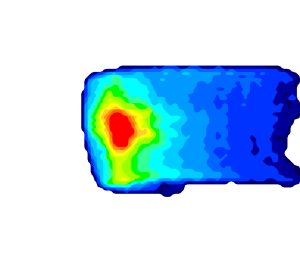This research is joint work with Dr. John Newhook, Dr. Michel Ladouceur, and Dr. Ryan Frayne of Dalhousie University in Halifax. John is a Professor of Civil Engineering and the Dean of Engineering at Dalhousie, while Michel and Ryan are assistant professors in the Kinesiology department of the School of Health and Human Performance at Dalhousie.
At the 2022 North American Conference on Biomechanics (NACOB) held the week of August 22-25 in Ottawa, we presented our initial work that compared a variety of commercial brush heads in how they distributed pressure across their pads in a static laboratory setup. Forces and pressures were recorded using two 3200E Tekscan (Tekscan Inc., Boston, MA) pressure sensors affixed to the top of an AMTI BP400600 force plate (AMTI Inc., Watertown MA), with the sensel areas abutted. CONFORMat Research software (version 7.1: Tekscan Inc.) was used to collect the pressure sensor data, which was recorded at a frequency of 100 Hz.
Our results are summarized on this poster (click on the image for the full-size PDF), which we presented at the Conference:
Our primary goals are to understand the forces involved in the physics of curling, how brushing forces influence the behaviour of curling stones, and what are the best approaches in brushing – including the biomechanics of the athlete – to create those desired influences. The catalyst for this particular study was the observation that brush pads from different manufacturers exhibit different patterns of wear and dirt in game play, and so we sought to quantify the pressure distribution characteristics of these various brush pads and determine if the distribution characteristics were related to these wear patterns. The testing was performed in February 2020 at the Dalhousie University BEN (Biodynamics, Ergonomics, and Neuroscience) Lab in the School of Health and Human Performance. Our results demonstrate that in a static measurement experiment, the different brush heads exhibit different pressure distributions and none of the tested brushes reflect the World Curling Federation (WCF) specification for brushing devices under the loads readily achieved by competitive athletes in game situations.
However, these results are but a first step. We need to assess if and how the pressure distributions change when the brush is in motion during a complete brush stroke, and we began that work this past March, again in the BEN lab at Dalhousie. Our work this spring involved testing a greater variety of commercially-available brushes, capturing digital video, OptiTrack positional data for the brush head and brush handle, and AMTI force plate data while performing a brushing motion over a specially-purchased Tekscan sensor mat. A still image of a movie composite of several strokes captured by the TekScan mat imaging software appears in the image at right. Our hope is to publish these findings sometime in 2023.
Once we have an understanding of dynamic brush pad pressure, and can characterize the asymmetry in the different commercially-available products, we can then conduct on-ice tests to determine the extent that a curling stone’s carry or trajectory can be influenced with different brushes by athletes with the same or different force profiles. Ideally, this may lead to:
- potential directions in new brush designs, specifically for athletes with different force profiles (eg. men versus women);
- a better understanding of the physics behind brushing, and applying this knowledge to the coaching of the sport;
- potential recommendations to changes to the existing WCF specification on sweeping devices. One idea is to develop a metric to represent the asymmetric pressure distribution characteristics for a brush, and define acceptable ranges of that metric that approved commercial products must fall within.

